Covid-19 facts checked
The truth about how you can catch coronavirus, who is most vulnerable and what you can do to avoid infection
Coronavirus – latest news and updates
What are the symptoms and should I see a doctor?
How to protect yourself against coronavirus
Hannah Devlin, Science correspondent 16 Mar 2020
Claim: ‘Face masks don’t work’
Wearing a face mask is certainly not an iron-clad guarantee that you won’t get sick – viruses can also transmit through the eyes and tiny viral particles, known as aerosols, can penetrate masks. However, masks are effective at capturing droplets, which is a main transmission route of coronavirus, and some studies have estimated a roughly fivefold protection versus no barrier alone (although others have found lower levels of effectiveness).
If you are likely to be in close contact with someone infected, a mask cuts the chance of the disease being passed on. If you’re showing symptoms of coronavirus, or have been diagnosed, wearing a mask can also protect others. So masks are crucial for health and social care workers looking after patients and are also recommended for family members who need to care for someone who is ill – ideally both the patient and carer should have a mask.
However, masks will probably make little difference if you’re just walking around town or taking a bus so there is no need to bulk-buy a huge supply.
Claim: ‘It is mutating into a more deadly strain’
All viruses accumulate mutations over time and the virus that causes Covid-19 is no different. How widespread different strains of a virus become depends on natural selection – the versions that can propagate quickest and replicate effectively in the body will be the most “successful”. This doesn’t necessarily mean most dangerous for people though, as viruses that kill people rapidly or make them so sick that they are incapacitated may be less likely to be transmitted.
Genetic analysis by Chinese scientists of 103 samples of the virus, taken from patients in Wuhan and other cities, suggests that early on two main strains emerged, designated L and S. Although the L strain appeared to be more prevalent than the S strain (about 70% of the samples belonged to the former), the S branch of the virus was found to be the ancestral version.
The team behind this research suggested that this may indicate the L strain is more “aggressive”, either transmitting more easily or replicating faster inside the body. However, this theory is speculative at this stage – there haven’t yet been direct comparisons to see whether people who catch one version of the virus are more likely to pass it on or suffer more severe symptoms.
Claim: ‘It is no more dangerous than winter flu’
Many individuals who get coronavirus will experience nothing worse than seasonal flu symptoms, but the overall profile of the disease, including its mortality rate, looks more serious. At the start of an outbreak the apparent mortality rate can be an overestimate if a lot of mild cases are being missed. But this week, a WHO expert suggested that this has not been the case with Covid-19. Bruce Aylward, who led an international mission to China to learn about the virus and the country’s response, said the evidence did not suggest that we were only seeing the tip of the iceberg. If borne out by further testing, this could mean that current estimates of a roughly 1% fatality rate are accurate. This would make Covid-19 about 10 times more deadly than seasonal flu, which is estimated to kill between 290,000 and 650,000 people a year globally.
Claim: ‘It only kills the elderly, so younger people can relax’
Most people who are not elderly and do not have underlying health conditions will not become critically ill from Covid-19. But the illness still has a higher chance of leading to serious respiratory symptoms than seasonal flu and there are other at-risk groups – health workers, for instance, are more vulnerable because they are likely to have higher exposure to the virus. The actions that young, healthy people take, including reporting symptoms and following quarantine instructions, will have an important role in protecting the most vulnerable in society and in shaping the overall trajectory of the outbreak.
Claim: ‘You need to be with an infected person for 10 minutes’
For flu, some hospital guidelines define exposure as being within six feet of an infected person who sneezes or coughs for 10 minutes or longer. However, it is possible to be infected with shorter interactions or even by picking the virus up from contaminated surfaces, although this is thought to be a less common route of transmission.
Claim: ‘A vaccine could be ready within a few months’
Scientists were quick out of the gates in beginning development of a vaccine for the new coronavirus, helped by the early release of the genetic sequence by Chinese researchers. The development of a viable vaccine continues apace, with several teams now testing candidates in animal experiments. However, the incremental trials required before a commercial vaccine could be rolled out are still a lengthy undertaking – and an essential one to ensure that even rare side-effects are spotted. A commercially available vaccine within a year would be quick.’
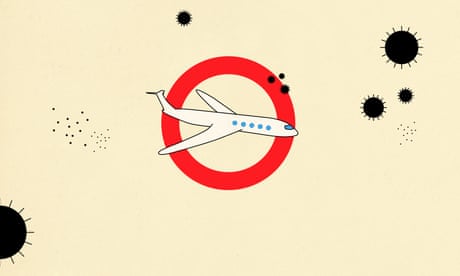
How to protect yourself against coronavirus
How to protect yourself against coronavirus How to avoid catching the coronavirus. A visual guide Illustration: Guardian Design
World Health Organization recommends people take these simple precautions against coronavirus to reduce exposure and transmission
What is the coronavirus?
Coronavirus outbreak – latest updates
by Hannah Devlin Science correspondent Tue 10 Mar 2020
How does the coronavirus spread?
The Covid-19 coronavirus outbreak is a new illness and scientists are still assessing how it spreads from person to person, but similar viruses tend to spread via cough and sneeze droplets.
When an infected person coughs or sneezes, they release droplets of saliva or mucus. These droplets can fall on people in the vicinity and can be either directly inhaled or picked up on the hands then transferred when someone touches their face, causing infection. For flu, some hospital guidelines define exposure as being within six feet of an infected person who sneezes or coughs for 10 minutes or longer.
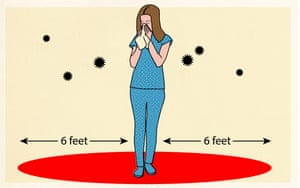
FacebookTwitterPinterest Stay six feet from infected individuals.
Viruses can also be spread through droplets landing on surfaces such as seats on buses or trains or desks in school. However, whether this is a main transmission route depends on how long viruses survive on surfaces – this can vary from hours to months.
There is anecdotal evidence that the virus can be spread by people before they have symptoms. Some other illnesses such as flu can be passed from one person to another before symptoms occur – but the extent to which this is happening with the new coronavirus is not well understood yet.
How to protect yourself and others

Wash your hands.
Wash your hands: wet your hands with clean, running water and apply soap. Lather your hands, including the backs, between your fingers, and under your nails and scrub for at least 20 seconds. Rinse.
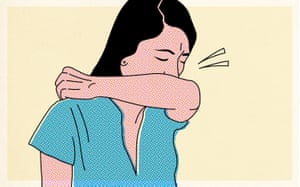
Cover your mouth.
Cover your mouth and nose with a tissue when you cough or sneeze, then throw the tissue in the bin and wash your hands. If you do not have a tissue to hand, cough or sneeze into your elbow rather than your hands.
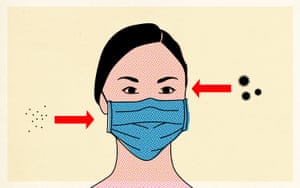
Face masks offer some protection.
Face masks offer some protection as they block liquid droplets. However, they do not block smaller aerosol particles that can pass through the material of the mask. The masks also leave the eyes exposed and there is evidence that some viruses can infect a person through the eyes.
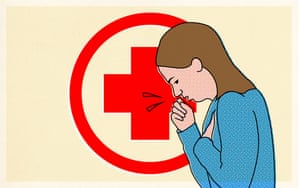
Seek medical help.
Seek early medical help if you have a fever, cough and difficulty breathing, and share your travel history with healthcare providers.
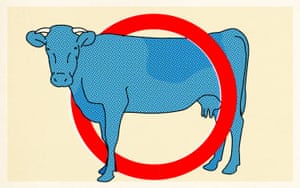
Face masks offer some protection as they block liquid droplets. However, they do not block smaller aerosol particles that can pass through the material of the mask. The masks also leave the eyes exposed and there is evidence that some viruses can infect a person through the eyes.

Seek medical help.
Seek early medical help if you have a fever, cough and difficulty breathing, and share your travel history with healthcare providers.

Avoid live animals.
If visiting live markets in affected areas avoid direct, unprotected contact with live animals and surfaces that have been in contact with animals.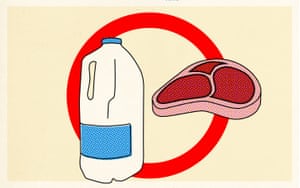
Avoid raw foods.
If you have returned from an affected area in the last two weeks, stay indoors and avoid contact with other people for 14 days. This means not going to work, school or public areas.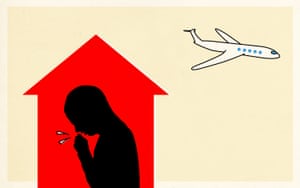
Seek medical advice before leaving home.
If you have returned from an infected area and develop a high temperature, cough, runny nose, sore throat or difficulty breathing do not leave your home until you have been given advice by a doctor.
If visiting live markets in affected areas avoid direct, unprotected contact with live animals and surfaces that have been in contact with animals.

Avoid raw foods.
If you have returned from an affected area in the last two weeks, stay indoors and avoid contact with other people for 14 days. This means not going to work, school or public areas.

Seek medical advice before leaving home.
If you have returned from an infected area and develop a high temperature, cough, runny nose, sore throat or difficulty breathing do not leave your home until you have been given advice by a doctor.
No comments:
Post a Comment